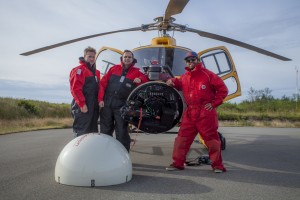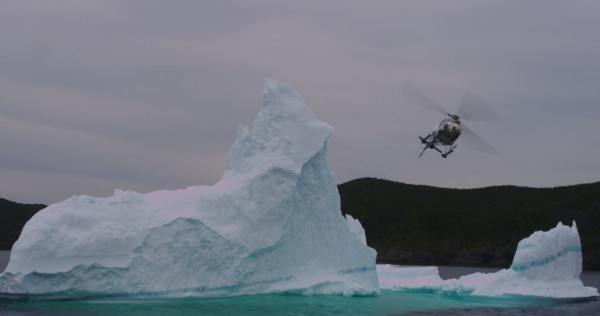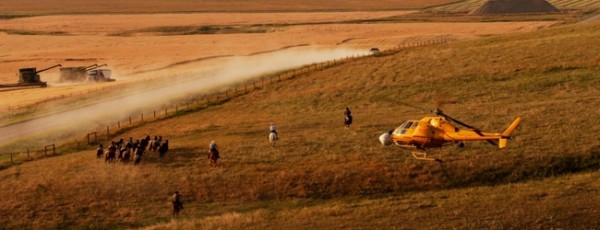Sherpas Cinema films aerial vistas for FlyOver Canada tourism ride
Sherpas Cinema and director Dave Mossop filmed aerial footage across Canada for new tourism ride FlyOver Canada. Launched at Canada Place in Vancouver, the ride is presented as a virtual flight, with the country’s most dramatic locations projected on a curving 180-degree screen.
 “The idea of the film,” explains Sherpas Cinema’s Production Manager Momme Halbe, “is to ‘fly’ the guests from the east coast to the west coast. The locations were mainly huge research of the most iconic and well-known places in Canada, as well as the hidden gems that nobody really knows about along the way.”
“The idea of the film,” explains Sherpas Cinema’s Production Manager Momme Halbe, “is to ‘fly’ the guests from the east coast to the west coast. The locations were mainly huge research of the most iconic and well-known places in Canada, as well as the hidden gems that nobody really knows about along the way.”
Filming on the production was entirely aerial and involved 25 separate locations shot during five trips over ten months, using a combination of helicopters and Learjets. Helicopter filming involved a Phantom 65 camera in a nose-mounted Eclipse system that used a 16mm spherical prime lens in order to capture a 180-degree field of view. Wolfe Air of Los Angeles was recruited for the Learjet scenes.
The locations were mainly huge research of the most iconic and well-known places in Canada, as well as the hidden gems that nobody really knows about along the way.
Momme Halbe, Sherpas Cinema
“Some of our scenes asked for long-distance travels and quick rises,” Halbe adds: “The Learjet was the only way to achieve this. We had to build a custom nose mount for the Phantom 65 that would fit and slide into their pre-existing nose mount system and would allow the same 180 degrees that we got from the Eclipse system on the helicopter.
 “This was by far the most complicated process, including tests in the Californian desert. The shots turned out incredibly well and are now the opening and ending scenes of the ride.”
“This was by far the most complicated process, including tests in the Californian desert. The shots turned out incredibly well and are now the opening and ending scenes of the ride.”
While Canada’s vistas are the major visual appeal, there are also scenes involving specific ground elements like kayakers, boats, horses and trains. Capturing these as aerial shots often required very low flying – sometimes barely ten feet off the ground – and this proved a challenge to get permitted locally.
National parks were wary of permitting low-altitude flying over busy areas and the team often had to keep a minimum distance from specific buildings. These restrictions also had to be balanced with the position of the sun so that the crew avoided filming their own shadow with their 180-degree field of view. Then there were the weather conditions to consider.
“In Niagara Falls all challenges came together,” Halbe recalls: “The weather forecast was rainy, which turned out to be sunny with small clouds. But we had to be 500 feet away from the restaurant right next to the falls, which would have brought the helicopter exactly over the big mist cloud. This didn't work for our flight path as we had to avoid any kind of rain or mist on the lens.
“After a few takes that didn't really work, the wind turned and pushed the mist slightly towards the other side of the falls and opened a little gap for the helicopter that the pilot could fly through and get us the perfect shot.”
(Images: Sherpas Cinema)
Related Posts
- Drone filming & the freedom of unmanned flight
- TLG talks to legendary film pilot Marc Wolff
- Aerial filming in the UK
- Partizan travels from Mexico to Alaska for Honda and films with a 360-degree camera
- Aerial filming equipment helps crews reach for the sky
- Jamiroquai films new music videos in Spain’s Almeria Desert
- Farm Film shoots Nissan commercial on location in South Africa
- Scouting in Western Norway: Where high-tech structures meet epic natural landscapes
Related posts:
Global Filming Incentive - Canada (see more…)
- Newfoundland & Labrador: Tax Credit
- NWT Travel Rebate
- NWT Expenditure Rebate
- Cost-Of-Production Tax Credit
- Cost-Of-Salaries Tax Credit
- Canada: Film or Video Production Tax Credit (CPTC)
- Canada: The Film or Video Production Services Tax Credit (PSTC)
- The Manitoba Film and Video Production Tax Credit: Frequent Filming Bonus
Comments
Not Logged in
You must be logged in to post a comment

There are no comments